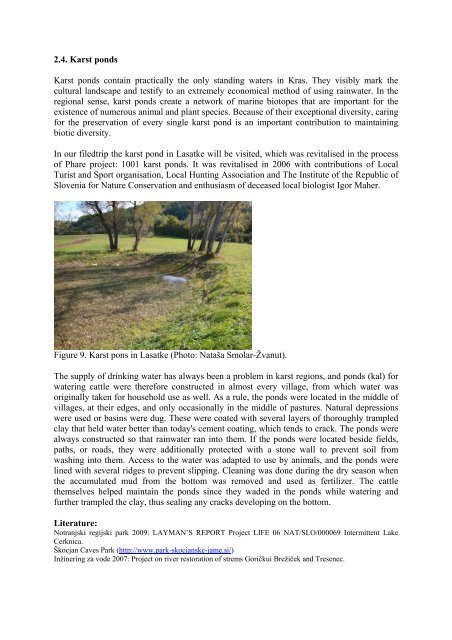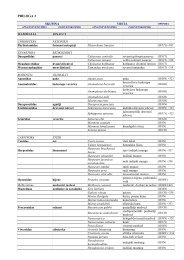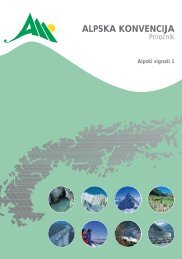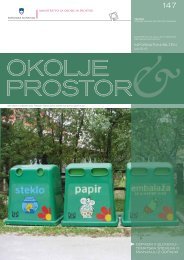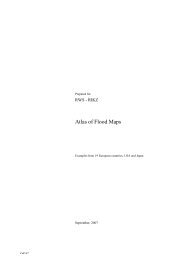The restoration of tributaries of Cerknica Lake and Škocjan Caves ...
The restoration of tributaries of Cerknica Lake and Škocjan Caves ...
The restoration of tributaries of Cerknica Lake and Škocjan Caves ...
You also want an ePaper? Increase the reach of your titles
YUMPU automatically turns print PDFs into web optimized ePapers that Google loves.
2.4. Karst ponds<br />
Karst ponds contain practically the only st<strong>and</strong>ing waters in Kras. <strong>The</strong>y visibly mark the<br />
cultural l<strong>and</strong>scape <strong>and</strong> testify to an extremely economical method <strong>of</strong> using rainwater. In the<br />
regional sense, karst ponds create a network <strong>of</strong> marine biotopes that are important for the<br />
existence <strong>of</strong> numerous animal <strong>and</strong> plant species. Because <strong>of</strong> their exceptional diversity, caring<br />
for the preservation <strong>of</strong> every single karst pond is an important contribution to maintaining<br />
biotic diversity.<br />
In our filedtrip the karst pond in Lasatke will be visited, which was revitalised in the process<br />
<strong>of</strong> Phare project: 1001 karst ponds. It was revitalised in 2006 with contributions <strong>of</strong> Local<br />
Turist <strong>and</strong> Sport organisation, Local Hunting Association <strong>and</strong> <strong>The</strong> Institute <strong>of</strong> the Republic <strong>of</strong><br />
Slovenia for Nature Conservation <strong>and</strong> enthusiasm <strong>of</strong> deceased local biologist Igor Maher.<br />
Figure 9. Karst pons in Lasatke (Photo: Nataša Smolar-Žvanut).<br />
<strong>The</strong> supply <strong>of</strong> drinking water has always been a problem in karst regions, <strong>and</strong> ponds (kal) for<br />
watering cattle were therefore constructed in almost every village, from which water was<br />
originally taken for household use as well. As a rule, the ponds were located in the middle <strong>of</strong><br />
villages, at their edges, <strong>and</strong> only occasionally in the middle <strong>of</strong> pastures. Natural depressions<br />
were used or basins were dug. <strong>The</strong>se were coated with several layers <strong>of</strong> thoroughly trampled<br />
clay that held water better than today's cement coating, which tends to crack. <strong>The</strong> ponds were<br />
always constructed so that rainwater ran into them. If the ponds were located beside fields,<br />
paths, or roads, they were additionally protected with a stone wall to prevent soil from<br />
washing into them. Access to the water was adapted to use by animals, <strong>and</strong> the ponds were<br />
lined with several ridges to prevent slipping. Cleaning was done during the dry season when<br />
the accumulated mud from the bottom was removed <strong>and</strong> used as fertilizer. <strong>The</strong> cattle<br />
themselves helped maintain the ponds since they waded in the ponds while watering <strong>and</strong><br />
further trampled the clay, thus sealing any cracks developing on the bottom.<br />
Literature:<br />
Notranjski regijski park 2009: LAYMAN’S REPORT Project LIFE 06 NAT/SLO/000069 Intermittent <strong>Lake</strong><br />
<strong>Cerknica</strong>.<br />
<strong>Škocjan</strong> <strong>Caves</strong> Park (http://www.park-skocjanske-jame.si/)<br />
Inžinering za vode 2007: Project on river <strong>restoration</strong> <strong>of</strong> strems Goričkui Brežiček <strong>and</strong> Tresenec.


